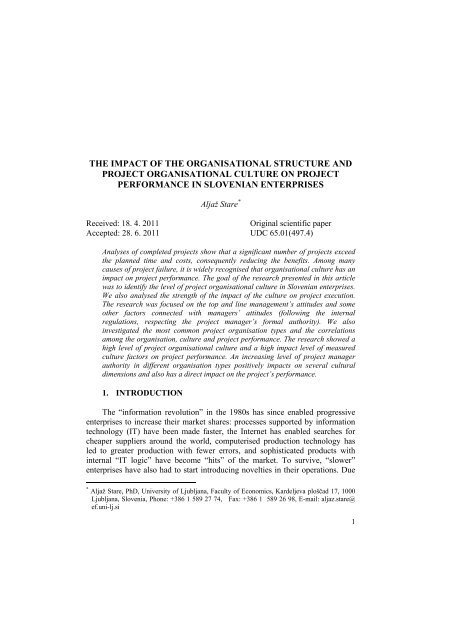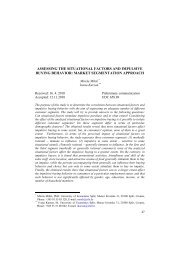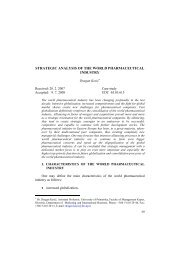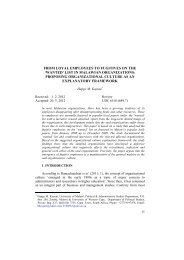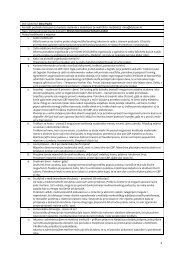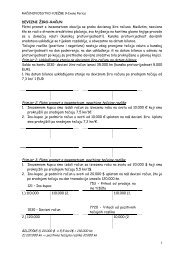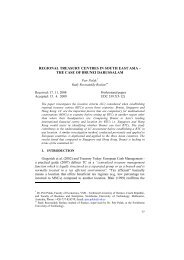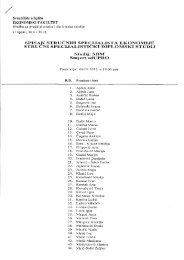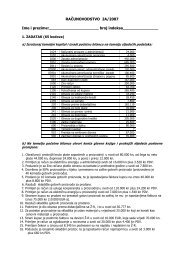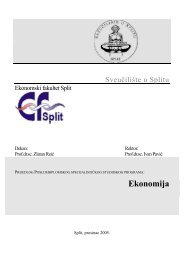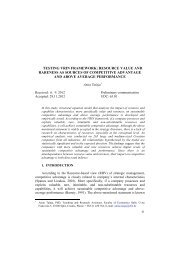the impact of the organisational structure and project organisational ...
the impact of the organisational structure and project organisational ...
the impact of the organisational structure and project organisational ...
Create successful ePaper yourself
Turn your PDF publications into a flip-book with our unique Google optimized e-Paper software.
THE IMPACT OF THE ORGANISATIONAL STRUCTURE AND<br />
PROJECT ORGANISATIONAL CULTURE ON PROJECT<br />
PERFORMANCE IN SLOVENIAN ENTERPRISES<br />
Aljaž Stare *<br />
Received: 18. 4. 2011<br />
Original scientific paper<br />
Accepted: 28. 6. 2011 UDC 65.01(497.4)<br />
Analyses <strong>of</strong> completed <strong>project</strong>s show that a significant number <strong>of</strong> <strong>project</strong>s exceed<br />
<strong>the</strong> planned time <strong>and</strong> costs, consequently reducing <strong>the</strong> benefits. Among many<br />
causes <strong>of</strong> <strong>project</strong> failure, it is widely recognised that <strong>organisational</strong> culture has an<br />
<strong>impact</strong> on <strong>project</strong> performance. The goal <strong>of</strong> <strong>the</strong> research presented in this article<br />
was to identify <strong>the</strong> level <strong>of</strong> <strong>project</strong> <strong>organisational</strong> culture in Slovenian enterprises.<br />
We also analysed <strong>the</strong> strength <strong>of</strong> <strong>the</strong> <strong>impact</strong> <strong>of</strong> <strong>the</strong> culture on <strong>project</strong> execution.<br />
The research was focused on <strong>the</strong> top <strong>and</strong> line management’s attitudes <strong>and</strong> some<br />
o<strong>the</strong>r factors connected with managers’ attitudes (following <strong>the</strong> internal<br />
regulations, respecting <strong>the</strong> <strong>project</strong> manager’s formal authority). We also<br />
investigated <strong>the</strong> most common <strong>project</strong> organisation types <strong>and</strong> <strong>the</strong> correlations<br />
among <strong>the</strong> organisation, culture <strong>and</strong> <strong>project</strong> performance. The research showed a<br />
high level <strong>of</strong> <strong>project</strong> <strong>organisational</strong> culture <strong>and</strong> a high <strong>impact</strong> level <strong>of</strong> measured<br />
culture factors on <strong>project</strong> performance. An increasing level <strong>of</strong> <strong>project</strong> manager<br />
authority in different organisation types positively <strong>impact</strong>s on several cultural<br />
dimensions <strong>and</strong> also has a direct <strong>impact</strong> on <strong>the</strong> <strong>project</strong>’s performance.<br />
1. INTRODUCTION<br />
The “information revolution” in <strong>the</strong> 1980s has since enabled progressive<br />
enterprises to increase <strong>the</strong>ir market shares: processes supported by information<br />
technology (IT) have been made faster, <strong>the</strong> Internet has enabled searches for<br />
cheaper suppliers around <strong>the</strong> world, computerised production technology has<br />
led to greater production with fewer errors, <strong>and</strong> sophisticated products with<br />
internal “IT logic” have become “hits” <strong>of</strong> <strong>the</strong> market. To survive, “slower”<br />
enterprises have also had to start introducing novelties in <strong>the</strong>ir operations. Due<br />
* Aljaž Stare, PhD, University <strong>of</strong> Ljubljana, Faculty <strong>of</strong> Economics, Kardeljeva ploščad 17, 1000<br />
Ljubljana, Slovenia, Phone: +386 1 589 27 74, Fax: +386 1 589 26 98, E-mail: aljaz.stare@<br />
ef.uni-lj.si<br />
1
Management, Vol. 16, 2011, 2, pp. 1-22<br />
A. Stare: The <strong>impact</strong> <strong>of</strong> <strong>the</strong> organizational <strong>structure</strong> <strong>and</strong> <strong>project</strong> organizational culture…<br />
to learning from “pioneers”, <strong>the</strong>ir business solutions were significantly better,<br />
so <strong>the</strong>y forced <strong>the</strong> previously more successful competitors to change yet again.<br />
Everything has started to improve more rapidly (knowledge, research,<br />
technology, methodologies, tools, products, etc.). Thus, <strong>the</strong> growing quantity<br />
<strong>and</strong> variety <strong>of</strong> frequently changing factors in <strong>the</strong> environment are forcing<br />
enterprises into constant adaptation through self-modification. While <strong>project</strong>s<br />
have proven to be <strong>the</strong> most efficient way <strong>of</strong> making changes <strong>and</strong> for introducing<br />
innovations, <strong>the</strong> number <strong>of</strong> <strong>project</strong>s in enterprises is constantly rising.<br />
Unfortunately, many <strong>project</strong>s do not bring <strong>the</strong> benefits for which <strong>the</strong>y were<br />
implemented. Analyses <strong>of</strong> completed <strong>project</strong>s show that a significant number <strong>of</strong><br />
<strong>project</strong>s exceeds <strong>the</strong> planned time <strong>and</strong> costs, consequently reducing <strong>the</strong> benefits.<br />
Research conducted in 1998 by "The St<strong>and</strong>ish Group" showed that only 26<br />
percent <strong>of</strong> <strong>the</strong> <strong>project</strong>s initiated were completed successfully 1 . According to<br />
Jones (White, 2006), <strong>the</strong>re is only a 65% chance that an IT <strong>project</strong> will meet <strong>the</strong><br />
<strong>project</strong> participants’ expectations, while Burke (2003) states that just 18% <strong>of</strong> IT<br />
<strong>project</strong>s are executed within budget, 50% <strong>of</strong> <strong>the</strong>m exceeded <strong>the</strong> planned costs,<br />
while 30% <strong>of</strong> <strong>the</strong> <strong>project</strong>s are so expensive that <strong>the</strong>y are cancelled before<br />
completion. Authors indicate many causes <strong>of</strong> <strong>project</strong> failure, such as a poor<br />
definition <strong>of</strong> <strong>the</strong> objectives, an inadequate <strong>project</strong> schedule, too much<br />
uncontrolled change, insufficient control, a lack <strong>of</strong> resources, ineffective<br />
communication, an unclear role <strong>of</strong> <strong>the</strong> participants, a lack <strong>of</strong> top management<br />
support, too many teams focussing on technical solutions <strong>and</strong> neglecting <strong>the</strong><br />
people (customer, user), etc. (Young, 2000; Andersen et al., 2004; White, 2006;<br />
The St<strong>and</strong>ish Group in Young & Jordan, 2008).<br />
In addition, <strong>the</strong> strong rise in <strong>the</strong> number <strong>of</strong> <strong>project</strong>s requires ever more<br />
employees to become involved, thus increasing <strong>the</strong> number <strong>of</strong> different<br />
relationships <strong>and</strong> frequency <strong>of</strong> contacts. The collaboration <strong>of</strong> <strong>project</strong><br />
stakeholders basically represents a disturbance to regular work <strong>and</strong> <strong>the</strong>refore<br />
leads to short tempers <strong>and</strong> <strong>the</strong> dislike <strong>of</strong> such <strong>project</strong>s by line (functional)<br />
managers. If <strong>the</strong> roles, responsibilities, competencies <strong>and</strong> relationships between<br />
<strong>project</strong> stakeholders are not properly defined <strong>and</strong> carried into effect, even more<br />
conflicts could arise, resulting in less efficient <strong>project</strong> execution.<br />
Slovenian enterprises have had to introduce a much bigger number <strong>of</strong><br />
changes in <strong>the</strong> last 20 years because up until <strong>the</strong> 1990s, <strong>the</strong>y had fewer<br />
competitors <strong>and</strong> could even survive with less efficient operation <strong>and</strong> relatively<br />
obsolete products. Due to <strong>the</strong> mentioned weaknesses <strong>and</strong> less well-organised<br />
1 http://www.pmmaturity.com<br />
2
Management, Vol. 16, 2011, 2, pp. 1-22<br />
A. Stare: The <strong>impact</strong> <strong>of</strong> <strong>the</strong> organizational <strong>structure</strong> <strong>and</strong> <strong>project</strong> organizational culture…<br />
work, certain special “culture factors” can even obstruct <strong>project</strong> work today.<br />
First <strong>of</strong> all, <strong>project</strong> plans are made in haste, usually without proper risk<br />
management, with <strong>the</strong> result that improvisation is quite a common way <strong>of</strong><br />
executing <strong>project</strong>s. The typical <strong>project</strong> organisation is a matrix, yet <strong>project</strong><br />
managers (85% <strong>of</strong> <strong>the</strong>m are entitled <strong>project</strong> leaders) are not “pr<strong>of</strong>essional<br />
managers”, but experts who perform many tasks <strong>and</strong> also co-ordinate <strong>the</strong><br />
<strong>project</strong>. Despite <strong>the</strong> <strong>of</strong>ficial internal rules governing how <strong>project</strong>s should be<br />
implemented, many stakeholders do not consider <strong>the</strong>m. The consequences are<br />
<strong>the</strong> low level <strong>of</strong> authority enjoyed by <strong>project</strong> managers, <strong>the</strong> low level <strong>of</strong> support<br />
<strong>of</strong> line managers, <strong>and</strong> unsuitable <strong>project</strong> teams. All <strong>of</strong> <strong>the</strong>se factors could be<br />
subsumed within <strong>project</strong> <strong>organisational</strong> culture, which forms part <strong>of</strong> <strong>the</strong><br />
corporate culture.<br />
PROJECT MANAGEMENT<br />
• Planning<br />
• Organising<br />
• Control<br />
• Leadership<br />
“<strong>project</strong> team culture”<br />
Team members’<br />
motivation<br />
Top & line management<br />
attitude<br />
EFFICIENT PROJECT EXECUTION<br />
Project organisation <strong>structure</strong><br />
& internal PM regulations<br />
Research frame<br />
Figure 1. Important factors in effective <strong>project</strong> execution<br />
It is widely recognised that <strong>organisational</strong> culture has an <strong>impact</strong> on <strong>project</strong><br />
performance (Brown, 2008; Andersen et al., 2009). Many studies have been<br />
carried out <strong>and</strong> several dimensions <strong>of</strong> <strong>organisational</strong> culture have been<br />
investigated, e.g. <strong>the</strong> <strong>organisational</strong> strategy, <strong>structure</strong>, culture, systems,<br />
behavioural patterns <strong>and</strong> processes <strong>of</strong> an organisation, <strong>the</strong>reby determining <strong>the</strong><br />
internal environment required for <strong>project</strong> management to be successful. A study<br />
<strong>of</strong> <strong>the</strong> literature reveals <strong>the</strong>re are three types <strong>of</strong> <strong>organisational</strong> culture <strong>impact</strong>s:<br />
3
Management, Vol. 16, 2011, 2, pp. 1-22<br />
A. Stare: The <strong>impact</strong> <strong>of</strong> <strong>the</strong> organizational <strong>structure</strong> <strong>and</strong> <strong>project</strong> organizational culture…<br />
<br />
<br />
<br />
corporate culture with an indirect influence – employees’ involvement,<br />
consistency (a strong internal culture, a concern with shared values),<br />
mission <strong>and</strong> long-term directions, adaptability to <strong>the</strong> environment (Kuo<br />
& Kuo, 2010); how decision-makers respond to ambiguity, complexity,<br />
<strong>and</strong> uncertainty (Shore, 2008); <strong>organisational</strong> direction, competitiveness<br />
orientation, decision-making rationale, cross-functional integration,<br />
communication philosophy, locus <strong>of</strong> decision-making, people<br />
management style, flexibility, philosophy about people, personal<br />
competency, process <strong>and</strong> systems support, performance management<br />
(Morrison et al., 2008; Brown, 2008; Aronson & Lechler, 2009);<br />
positive work environment, management leadership, results-oriented,<br />
commercial success, technical success, customer satisfaction (Belassi et<br />
al., 2007); strong comm<strong>and</strong> <strong>and</strong> control capabilities or a more<br />
empowered work style (Moore, 2002); very lax “we are all friends<br />
here” or very formal “buttoned down” cultures (Snedaker, 2006);<br />
hierarchy, market, clan <strong>and</strong> adhocracy culture (Fong & Kwok, 2009);<br />
<strong>project</strong> <strong>organisational</strong> culture (a direct influence) – top <strong>and</strong> line<br />
management supporting/attitude, monitoring, prioritisation <strong>and</strong> <strong>project</strong><br />
staffing (Kerzner, 2009, Andersen et al., 2009, Young & Jordan, 2008;<br />
Kearns, 2007; Tinnirello 2001; Doll, 1985); <strong>organisational</strong> policies,<br />
procedures, rules, formal <strong>and</strong> informal roles (Clel<strong>and</strong>, 1999); support <strong>of</strong><br />
departments in <strong>the</strong> pursuit <strong>of</strong> <strong>project</strong> goals, employee commitment to<br />
<strong>the</strong> <strong>project</strong> goals in <strong>the</strong> context <strong>of</strong> balancing <strong>the</strong>m with o<strong>the</strong>r, potentially<br />
competing goals, <strong>project</strong> planning – <strong>the</strong> way work is estimated or how<br />
resources are assigned to <strong>project</strong>s, performance <strong>of</strong> <strong>project</strong> teams – how<br />
managers evaluate it <strong>and</strong> how <strong>the</strong>y view <strong>the</strong> outcomes <strong>of</strong> <strong>project</strong>s<br />
(Pinto, 2010); <strong>and</strong><br />
<strong>the</strong> “subculture” <strong>of</strong> <strong>the</strong> <strong>project</strong> team (a direct influence) – effective<br />
communications, co-operation, trust <strong>and</strong> teamwork (Kerzner, 2001),<br />
willingness to share ideas <strong>and</strong> problems among team members, social<br />
activities <strong>of</strong> <strong>the</strong> team, calling team members by <strong>the</strong>ir first names or<br />
nicknames, level <strong>of</strong> formality within <strong>the</strong> team (Clel<strong>and</strong>, 1999).<br />
Recent research has mainly focused on <strong>the</strong> influence <strong>of</strong> <strong>the</strong> <strong>organisational</strong><br />
culture <strong>of</strong> <strong>the</strong> base organisation (corporate culture) on <strong>project</strong>s. However, our<br />
research focuses more on <strong>the</strong> second viewpoint <strong>of</strong> <strong>organisational</strong> culture – top<br />
<strong>and</strong> line management’s attitudes, <strong>and</strong> some o<strong>the</strong>r factors connected with<br />
managers’ attitudes.<br />
To our knowledge, such research has not been undertaken in <strong>the</strong> last<br />
decade, especially in countries labelled “transition economy countries” in <strong>the</strong><br />
4
Management, Vol. 16, 2011, 2, pp. 1-22<br />
A. Stare: The <strong>impact</strong> <strong>of</strong> <strong>the</strong> organizational <strong>structure</strong> <strong>and</strong> <strong>project</strong> organizational culture…<br />
1990s, where <strong>the</strong> management <strong>of</strong> <strong>project</strong>s (in our view) is still less organised,<br />
where <strong>the</strong> <strong>project</strong> management pr<strong>of</strong>ession has not been completely<br />
implemented, <strong>and</strong> where improvisation exerts a relatively big influence on work<br />
performance.<br />
Therefore, <strong>the</strong> goal <strong>of</strong> this study was to identify:<br />
<br />
<br />
<br />
<br />
<strong>the</strong> level <strong>of</strong> <strong>project</strong> <strong>organisational</strong> culture in Slovenian enterprises;<br />
which types <strong>of</strong> organisation have been implemented in Slovenian<br />
enterprises, <strong>and</strong> which <strong>organisational</strong> type is <strong>the</strong> most common;<br />
<strong>the</strong> <strong>impact</strong> <strong>of</strong> each type <strong>of</strong> organisation <strong>and</strong> cultural factors on efficient<br />
<strong>project</strong> execution; <strong>and</strong><br />
whe<strong>the</strong>r efficient <strong>project</strong> execution depends more on <strong>the</strong> <strong>organisational</strong><br />
culture or on <strong>the</strong> type <strong>of</strong> organisation.<br />
We believe that, due to <strong>the</strong> ever greater number <strong>of</strong> <strong>project</strong>s in <strong>the</strong> future,<br />
more stress should be placed on <strong>project</strong> culture <strong>and</strong> <strong>structure</strong>s will perhaps<br />
become less important or even more flexible because many employees will be<br />
members <strong>of</strong> many <strong>project</strong> teams for a short time. The issue discussed in <strong>the</strong><br />
paper is especially important for top <strong>and</strong> line managers whose behaviour is<br />
more crucial for <strong>the</strong> success <strong>of</strong> <strong>project</strong>s than <strong>the</strong>y may be aware <strong>of</strong>.<br />
This paper is organised in four sections. After <strong>the</strong> introduction, we begin<br />
with a brief overview <strong>of</strong> <strong>the</strong> literature on <strong>project</strong> <strong>organisational</strong> culture <strong>and</strong><br />
typical <strong>project</strong> <strong>organisational</strong> <strong>structure</strong>s. In <strong>the</strong> following section, we present <strong>the</strong><br />
empirical research we conducted in Slovenian enterprises – <strong>the</strong> research<br />
method, <strong>the</strong> findings <strong>of</strong> <strong>the</strong> research (<strong>the</strong> level <strong>of</strong> <strong>the</strong> selected <strong>organisational</strong><br />
cultural dimensions <strong>and</strong> <strong>the</strong> way <strong>project</strong>s are organised), <strong>the</strong> analysed <strong>impact</strong> <strong>of</strong><br />
<strong>the</strong> researched factors on <strong>project</strong> performance, <strong>and</strong> a discussion <strong>of</strong> <strong>the</strong> results <strong>of</strong><br />
<strong>the</strong> analysis. In conclusion, we outline <strong>the</strong> contribution to science <strong>and</strong> practice<br />
<strong>and</strong> suggest fur<strong>the</strong>r research direcions.<br />
2. THEORETICAL DETERMINANTS OF THE STUDY<br />
2.1. Project <strong>organisational</strong> culture<br />
2.1.1. Organisational (corporate) culture<br />
Organisational culture is one <strong>of</strong> <strong>the</strong> most influential dimensions <strong>of</strong> <strong>the</strong><br />
work climate <strong>and</strong> consecutively <strong>the</strong> main driving force <strong>of</strong> a business. It is<br />
5
Management, Vol. 16, 2011, 2, pp. 1-22<br />
A. Stare: The <strong>impact</strong> <strong>of</strong> <strong>the</strong> organizational <strong>structure</strong> <strong>and</strong> <strong>project</strong> organizational culture…<br />
reflected in <strong>the</strong> way tasks are realised, goals are set <strong>and</strong> in how people are<br />
guided toward <strong>the</strong> achievement <strong>of</strong> goals. Culture affects decision-making,<br />
thinking, feeling <strong>and</strong> <strong>the</strong> response to opportunities <strong>and</strong> threats. It also affects<br />
how people are chosen for a particular task, which affects performances <strong>and</strong><br />
decision taking.<br />
Culture is rooted in people <strong>and</strong> subconsciously influences <strong>the</strong>ir behaviour –<br />
it affects <strong>the</strong>ir performance <strong>and</strong> vice versa – <strong>the</strong> manner <strong>of</strong> <strong>the</strong>se factors affects<br />
<strong>the</strong> culture. Informally, such culture can be described as follows: “That’s <strong>the</strong><br />
way we do it!” (Lipičnik, 1993) or “The way things are done around here”<br />
(Lewis, 1995). Culture is <strong>the</strong> different philosophies <strong>and</strong> approaches to doing<br />
work within an organisation (Moore, 2002).<br />
Organisational culture has a number <strong>of</strong> underlying factors – it is formed by<br />
a set <strong>of</strong> values, beliefs, assumptions, common underst<strong>and</strong>ings, expectations,<br />
attitudes, behaviours, thinking, norms <strong>and</strong> traditions <strong>of</strong> <strong>the</strong> people in <strong>the</strong><br />
company (Davidson, 2000; Yazici, 2009; Mobley in Kuo & Kuo, 2010;<br />
Hooijberg & Petrock in Fong & Kwok, 2009), <strong>and</strong> is also affected by ethnic<br />
cultures (Lewis, 1995). Culture also represents a person's attitudes arising out <strong>of</strong><br />
<strong>the</strong>ir pr<strong>of</strong>essional, religious, class, educational, gender, age <strong>and</strong> o<strong>the</strong>r<br />
backgrounds <strong>and</strong> people’s capacity for learning <strong>and</strong> transmitting knowledge<br />
(Turner & Simister, 2000, PMBOK, 1987, www. maxwideman.com). It can be<br />
described by three levels: artefacts, espoused values, <strong>and</strong> basic, underlying<br />
assumptions (Eskerod & Skriver, 2007).<br />
All <strong>of</strong> <strong>the</strong> mentioned dimensions <strong>of</strong> culture are shared by all members <strong>of</strong> an<br />
enterprise <strong>and</strong> guide how employees get work done. The <strong>organisational</strong> context<br />
<strong>of</strong> a culture serves as a foundation for <strong>the</strong> methods <strong>of</strong> operation, an<br />
organisation's management system as well as a set <strong>of</strong> management practices <strong>and</strong><br />
behaviours that both exemplify <strong>and</strong> reinforce those basic principles (Davidson,<br />
2000).<br />
6<br />
2.1.2. Project culture<br />
Project culture is one <strong>of</strong> <strong>the</strong> most influential factors <strong>of</strong> successful <strong>project</strong><br />
implementation in enterprises <strong>and</strong> is part <strong>of</strong> <strong>the</strong> overall <strong>organisational</strong> culture<br />
(Skarabot, 1998). Project culture is <strong>the</strong> general attitude to <strong>project</strong>s within <strong>the</strong><br />
business. Most <strong>project</strong>s do not operate in isolation; <strong>the</strong>y have to operate within a<br />
business environment that should be complementary to <strong>the</strong> requirements <strong>of</strong><br />
good <strong>project</strong> management. The culture affects strategic planning <strong>and</strong><br />
implementation, <strong>project</strong> management, <strong>and</strong> everything else (Clel<strong>and</strong>, 1999).
Management, Vol. 16, 2011, 2, pp. 1-22<br />
A. Stare: The <strong>impact</strong> <strong>of</strong> <strong>the</strong> organizational <strong>structure</strong> <strong>and</strong> <strong>project</strong> organizational culture…<br />
Pinto (2010) reveals four ways <strong>organisational</strong> culture can affect <strong>project</strong><br />
management. First, it affects how departments are expected to interact <strong>and</strong><br />
support each o<strong>the</strong>r in <strong>the</strong> pursuit <strong>of</strong> <strong>project</strong> goals. Second, <strong>the</strong> culture influences<br />
<strong>the</strong> level <strong>of</strong> employee commitment to <strong>the</strong> goals <strong>of</strong> <strong>the</strong> <strong>project</strong> in <strong>the</strong> context <strong>of</strong><br />
balancing <strong>the</strong>m with o<strong>the</strong>r, potentially competing goals. Third, <strong>the</strong><br />
<strong>organisational</strong> culture influences <strong>project</strong> planning processes such as <strong>the</strong> way<br />
work is estimated or how resources are assigned to <strong>project</strong>s. Finally, <strong>the</strong> culture<br />
affects how managers evaluate <strong>the</strong> performance <strong>of</strong> <strong>project</strong> teams <strong>and</strong> how <strong>the</strong>y<br />
view <strong>project</strong>s’ outcomes.<br />
The most important issue is top <strong>and</strong> senior management support (Kerzner,<br />
2001; Tinnirello, 2001). The lack <strong>of</strong> top management involvement is <strong>the</strong><br />
primary challenge <strong>project</strong> managers felt was most deserving <strong>of</strong> <strong>the</strong>ir attention<br />
(Simonsen, 2007). Young & Jordan (2008) provide <strong>the</strong> following definition <strong>of</strong><br />
top management support: CEO <strong>and</strong> o<strong>the</strong>r senior managers devote time to review<br />
plans, follow up on results <strong>and</strong> facilitate management problems. The<br />
relationship between <strong>project</strong> management <strong>and</strong> senior management is equally<br />
important. A good relationship with executive management, specifically <strong>the</strong><br />
executive sponsor, includes <strong>the</strong>se factors (Kerzner, 2001):<br />
<br />
<br />
<br />
<br />
The <strong>project</strong> manager is empowered to make <strong>project</strong>-related decisions.<br />
This is done through <strong>the</strong> decentralisation <strong>of</strong> authority <strong>and</strong> decisionmaking.<br />
The sponsor is briefed periodically while maintaining a h<strong>and</strong>s-<strong>of</strong>f, but<br />
available, position. The <strong>project</strong> manager (<strong>and</strong> o<strong>the</strong>r <strong>project</strong> personnel) is<br />
encouraged to present recommendations <strong>and</strong> alternatives ra<strong>the</strong>r than just<br />
problems.<br />
Exactly what needs to be included in a meaningful executive status<br />
report has been formulated.<br />
A policy is in place that calls for periodic briefings.<br />
Perhaps <strong>the</strong> most important task <strong>of</strong> top management regarding <strong>project</strong>s is to<br />
develop a mutually agreed priority scheme for <strong>project</strong> screening <strong>and</strong> selection<br />
(Doll, 1985). That author focused on top management’s involvement in <strong>project</strong>s<br />
to develop <strong>the</strong> management information system, but in our experience, this issue<br />
is important across all kinds <strong>of</strong> <strong>project</strong>s. Top management decides whe<strong>the</strong>r<br />
<strong>project</strong>s will be executed, <strong>the</strong>y establish <strong>the</strong> priorities, <strong>and</strong> <strong>the</strong>y define who <strong>the</strong><br />
<strong>project</strong> sponsors are.<br />
Co-operative cultures require effective management support at all levels<br />
<strong>and</strong> <strong>the</strong> interface between <strong>project</strong> management <strong>and</strong> line management is critical.<br />
7
Management, Vol. 16, 2011, 2, pp. 1-22<br />
A. Stare: The <strong>impact</strong> <strong>of</strong> <strong>the</strong> organizational <strong>structure</strong> <strong>and</strong> <strong>project</strong> organizational culture…<br />
A matrix organisation is particularly important, where responsibility for <strong>the</strong><br />
<strong>project</strong> is shared between <strong>the</strong> <strong>project</strong> managers <strong>and</strong> line managers (Levine,<br />
2002). Effective relationships with line management are based on <strong>the</strong> following<br />
factors (Kerzner, 2001):<br />
<br />
<br />
<br />
<br />
Project managers <strong>and</strong> line managers are toge<strong>the</strong>r accountable for <strong>the</strong><br />
successful completion <strong>of</strong> a <strong>project</strong>. Line managers must keep <strong>the</strong>ir<br />
promises to <strong>the</strong> <strong>project</strong> managers.<br />
Project managers negotiate with line managers for <strong>the</strong> accomplishment<br />
<strong>of</strong> deliverables ra<strong>the</strong>r than for specific talent. Project managers can<br />
request specific talent, but <strong>the</strong> final decision on staffing belongs to <strong>the</strong><br />
line manager.<br />
Line managers trust <strong>the</strong>ir employees enough to empower those<br />
employees to make decisions related to <strong>the</strong>ir specific functional area<br />
without continuously having to run back to <strong>the</strong>ir line manager.<br />
If a line manager is unable to keep a promise he/she has made regarding<br />
a <strong>project</strong>, <strong>the</strong>n <strong>the</strong> <strong>project</strong> manager must do everything possible to help<br />
<strong>the</strong> line manager develop alternative plans.<br />
Both <strong>the</strong> <strong>project</strong> <strong>and</strong> line manager can develop a mutually agreeable <strong>project</strong><br />
culture <strong>and</strong> working relationship. There are four typical cultures (Kerzner &<br />
Saladis, 2009):<br />
<br />
<br />
<br />
<br />
co-operative – based on trust, communication, teamwork, <strong>and</strong> cooperation;<br />
competitive – each one tries to advance at <strong>the</strong> expense <strong>of</strong> <strong>the</strong> o<strong>the</strong>r;<br />
isolated – <strong>the</strong> functional unit creates its own culture, <strong>and</strong> <strong>the</strong> <strong>project</strong><br />
manager must manage work according to that culture or risk alienating<br />
<strong>the</strong> line manager <strong>and</strong> <strong>the</strong> functional group; <strong>and</strong><br />
fragmented – this appears in multinational <strong>project</strong>s <strong>and</strong> virtual teams.<br />
Ano<strong>the</strong>r important issue <strong>of</strong> <strong>project</strong> culture is <strong>the</strong> <strong>organisational</strong> policies,<br />
procedures, rules <strong>and</strong> strategies; <strong>the</strong> tools <strong>and</strong> principles <strong>of</strong> <strong>project</strong> work in <strong>the</strong><br />
enterprise (Clel<strong>and</strong>, 1999; Kerzner, 2001). Its “<strong>project</strong> management<br />
methodology” must not simply be <strong>the</strong>oretical <strong>and</strong> found solely on pieces <strong>of</strong><br />
paper; it must be converted into a world-class methodology in <strong>the</strong> way in which<br />
<strong>the</strong> corporate culture executes <strong>the</strong> methodology. Companies which excel in<br />
<strong>project</strong> management have co-operative cultures where <strong>the</strong> entire organisation<br />
supports a singular methodology.<br />
8
Management, Vol. 16, 2011, 2, pp. 1-22<br />
A. Stare: The <strong>impact</strong> <strong>of</strong> <strong>the</strong> organizational <strong>structure</strong> <strong>and</strong> <strong>project</strong> organizational culture…<br />
People <strong>of</strong>ten strongly resist following a st<strong>and</strong>ardised process (Tinnirello,<br />
2001). This is especially difficult in an environment where people have not been<br />
educated in <strong>the</strong> methods, <strong>and</strong> <strong>the</strong> <strong>project</strong> has been carried out for many years in<br />
an ad hoc environment. Employees also fear that such a process stifles creativity<br />
<strong>and</strong> <strong>the</strong> empowerment <strong>of</strong> people. However, st<strong>and</strong>ardisation enables <strong>the</strong> efficient<br />
<strong>and</strong> effective execution <strong>of</strong> <strong>project</strong> activities through consistency; it enables <strong>the</strong><br />
better integration <strong>of</strong> activities because team members can see <strong>the</strong><br />
interrelationships <strong>of</strong> <strong>the</strong>ir work with that <strong>of</strong> o<strong>the</strong>rs; <strong>and</strong> third, it reduces rework<br />
because it enables <strong>the</strong> use <strong>of</strong> output developed in earlier <strong>project</strong>s. Regardless <strong>of</strong><br />
how <strong>the</strong> organisation obtains a st<strong>and</strong>ardised process, <strong>the</strong> key is to develop or<br />
adopt one that people can agree on <strong>and</strong> that it is compatible with <strong>the</strong> company’s<br />
culture.<br />
According to Skarabot (1994), <strong>project</strong> <strong>organisational</strong> culture is best<br />
exemplified by <strong>the</strong> position <strong>of</strong> <strong>the</strong> <strong>project</strong> manager in <strong>the</strong> company <strong>and</strong> <strong>the</strong><br />
attitude <strong>of</strong> employees to <strong>the</strong> <strong>project</strong>. The <strong>project</strong> manager’s authority should<br />
depend on <strong>the</strong> level <strong>of</strong> <strong>the</strong> <strong>project</strong>; <strong>the</strong> manager <strong>of</strong> a <strong>project</strong> with a high priority<br />
should have similar competencies as line managers <strong>and</strong> should be paid as a<br />
manager. However, <strong>the</strong> informal role <strong>of</strong> a <strong>project</strong> manager could be even more<br />
important (Clel<strong>and</strong>, 1999).<br />
Based on <strong>the</strong> <strong>the</strong>ory presented above, we postulate:<br />
H1. Project <strong>organisational</strong> culture provides for <strong>the</strong> more efficient<br />
execution <strong>of</strong> a <strong>project</strong>.<br />
2.2. Project <strong>organisational</strong> <strong>structure</strong>s<br />
To avoid or at least to minimise <strong>the</strong> number <strong>of</strong> potential conflicts related to<br />
<strong>project</strong> work, enterprises have established different types <strong>of</strong> organisations. The<br />
best known types are functional, matrix <strong>and</strong> <strong>project</strong>-based organisations.<br />
Each <strong>of</strong> <strong>the</strong>m establishes different relations between <strong>project</strong> stakeholders,<br />
especially between <strong>project</strong> <strong>and</strong> line managers.<br />
A definition <strong>of</strong> <strong>the</strong> different types <strong>of</strong> <strong>project</strong> <strong>organisational</strong> <strong>structure</strong>s can<br />
be found in almost every <strong>project</strong> management book published in <strong>the</strong> last 30<br />
years. In this paragraph, I will briefly summarise some definitions. Since it is<br />
strongly connected with <strong>the</strong> <strong>project</strong> <strong>organisational</strong> culture, <strong>the</strong> formal <strong>and</strong><br />
informal role <strong>of</strong> line/functional managers in a matrix organisation is particularly<br />
important. Therefore, this issue is described in more detail.<br />
9
Management, Vol. 16, 2011, 2, pp. 1-22<br />
A. Stare: The <strong>impact</strong> <strong>of</strong> <strong>the</strong> organizational <strong>structure</strong> <strong>and</strong> <strong>project</strong> organizational culture…<br />
The functional organisation is <strong>the</strong> classical organisation <strong>and</strong> consists <strong>of</strong><br />
purchasing, HRM, production, sales, finance department, etc. If a company<br />
starts such a <strong>project</strong>, this <strong>structure</strong> is unsuitable unless some changes are<br />
introduced. Employees from different departments are required to undertake<br />
additional <strong>project</strong> tasks, while <strong>the</strong> <strong>project</strong>’s management is assigned to a person<br />
within <strong>the</strong> functional organisation. All <strong>project</strong> activities, including management,<br />
represent additional tasks. The advantage <strong>of</strong> this solution is that nothing<br />
changes within <strong>the</strong> existing <strong>organisational</strong> <strong>structure</strong> by <strong>the</strong> introduction <strong>of</strong> such<br />
<strong>project</strong>s. The main disadvantage is that team members always give priority to<br />
<strong>the</strong>ir usual or functional duties. We can argue that this solution is appropriate in<br />
<strong>the</strong> case <strong>of</strong> starting a few <strong>project</strong>s.<br />
In <strong>the</strong> case <strong>of</strong> a <strong>project</strong>-based organisation, <strong>the</strong> <strong>project</strong> is assigned to a<br />
group <strong>of</strong> employees who are organised within a new department. Members <strong>of</strong><br />
<strong>the</strong> <strong>project</strong> team only work on <strong>project</strong> tasks; thus, being occupied with o<strong>the</strong>r<br />
regular activities is no excuse. The <strong>project</strong> manager, with <strong>the</strong> same authority as<br />
line managers, is responsible solely for <strong>the</strong> <strong>project</strong> <strong>and</strong> <strong>the</strong>re is no need for cooperation<br />
with line managers. Strong team work exists in <strong>the</strong> department. The<br />
main disadvantages are team members who are not fully occupied, <strong>the</strong> reduced<br />
connection <strong>of</strong> team members with <strong>the</strong> business functions, <strong>and</strong> <strong>the</strong> problem <strong>of</strong><br />
employment after <strong>the</strong> <strong>project</strong> finishes.<br />
The <strong>project</strong> matrix <strong>structure</strong> is a combination <strong>of</strong> <strong>the</strong> above-mentioned<br />
<strong>structure</strong>s. Every employee can carry out <strong>the</strong>ir regular activities within <strong>the</strong><br />
business function <strong>and</strong>, at <strong>the</strong> same time, be assigned to <strong>the</strong> <strong>project</strong> to conduct<br />
some unique <strong>project</strong> activities. The member is thus subordinated to <strong>the</strong> line<br />
manager (for <strong>the</strong>ir regular work) <strong>and</strong> to <strong>the</strong> <strong>project</strong> manager. The matrix<br />
<strong>structure</strong> is characterised by <strong>the</strong> simultaneous presence <strong>of</strong> both <strong>project</strong> <strong>and</strong><br />
functional components. These components are administratively independent,<br />
but interdependent in <strong>the</strong> execution <strong>of</strong> <strong>project</strong>s. This arrangement permits<br />
functional components to maintain an independent existence <strong>and</strong> to pursue <strong>the</strong>ir<br />
regular activities, while providing <strong>the</strong> specialised resources needed for <strong>the</strong><br />
execution <strong>of</strong> <strong>project</strong>s. In general, <strong>the</strong> specialists remain permanently under <strong>the</strong><br />
authority <strong>of</strong> <strong>the</strong> line managers, but <strong>the</strong>ir services are lent out to <strong>the</strong> <strong>project</strong>s on a<br />
temporary basis in line with <strong>project</strong> needs. The functional components thus<br />
become centralised reservoirs <strong>of</strong> specialised resources.<br />
The advantages <strong>of</strong> a matrix organisation include <strong>the</strong> more direct contact<br />
among different disciplines, <strong>the</strong> fact that people can work on a variety <strong>of</strong><br />
problems, a strong technical base can be developed, <strong>and</strong> much more time can be<br />
devoted to complex problem-solving, <strong>and</strong> shared authority <strong>and</strong> responsibility.<br />
10
Management, Vol. 16, 2011, 2, pp. 1-22<br />
A. Stare: The <strong>impact</strong> <strong>of</strong> <strong>the</strong> organizational <strong>structure</strong> <strong>and</strong> <strong>project</strong> organizational culture…<br />
Yet, it has also some weaknesses: a two-boss syndrome <strong>and</strong> dual reporting,<br />
management co-operation is required, <strong>the</strong> balance <strong>of</strong> power between <strong>the</strong><br />
functional <strong>and</strong> <strong>project</strong> organisation, <strong>and</strong> a conflict <strong>of</strong> priorities amongst different<br />
<strong>project</strong>s (Dinsmore, 1993; Forsberg et al., 2005; Kerzner, 2003).<br />
The <strong>project</strong> manager has total responsibility <strong>and</strong> accountability for <strong>the</strong><br />
<strong>project</strong>’s success. The functional departments, on <strong>the</strong> o<strong>the</strong>r h<strong>and</strong>, have <strong>the</strong><br />
functional responsibility to maintain technical excellence in <strong>the</strong> <strong>project</strong>. Each<br />
functional unit is headed by a line manager whose prime responsibility is to<br />
ensure that a unified technical base is maintained <strong>and</strong> that all available<br />
information can be exchanged for each <strong>project</strong>. Line managers must also keep<br />
<strong>the</strong>ir people aware <strong>of</strong> <strong>the</strong> latest technical developments in <strong>the</strong> industry (Kerzner,<br />
2003).<br />
Three types <strong>of</strong> <strong>the</strong> matrix organisation are applied in practice. A weak<br />
matrix has many characteristics <strong>of</strong> a functional organisation with one important<br />
difference – a <strong>project</strong> co-ordinator is defined. One has little authority (coordinates<br />
different departments), but also fewer responsibilities – line managers<br />
are responsible for task execution <strong>and</strong> <strong>the</strong> motivation <strong>of</strong> employees.<br />
A strong matrix has many <strong>of</strong> <strong>the</strong> characteristics <strong>of</strong> <strong>the</strong> <strong>project</strong>-based<br />
organisation <strong>and</strong> can have full-time <strong>project</strong> managers with considerable<br />
authority <strong>and</strong> full-time <strong>project</strong> administrative staff. While a balanced matrix<br />
organisation recognises <strong>the</strong> need for a <strong>project</strong> manager, it does not provide <strong>the</strong><br />
<strong>project</strong> manager with full authority over <strong>the</strong> <strong>project</strong> (PMBOK, 2004).<br />
The most important aspect for our research is <strong>the</strong> division <strong>of</strong> competencies<br />
among <strong>project</strong> <strong>and</strong> functional managers in different types <strong>of</strong> organisations.<br />
From <strong>the</strong> functional across all types <strong>of</strong> matrix to <strong>the</strong> <strong>project</strong>-based organisation,<br />
<strong>the</strong> competencies <strong>of</strong> <strong>project</strong> managers increase, whereas <strong>the</strong> competencies <strong>of</strong><br />
functional managers decrease. In <strong>the</strong> case <strong>of</strong> a low <strong>project</strong> culture, some<br />
functional managers do not want to h<strong>and</strong> <strong>the</strong>ir authority over to <strong>project</strong><br />
managers. In addition, <strong>the</strong>ir low support for a <strong>project</strong> can result in less qualified<br />
team members being delegated to a <strong>project</strong>, while <strong>the</strong>ir low level <strong>of</strong> interest in<br />
<strong>the</strong> <strong>project</strong> can also lead to <strong>the</strong> poor quality <strong>of</strong> <strong>the</strong> results connected with <strong>the</strong><br />
pr<strong>of</strong>ession that one’s department covers. Based on <strong>the</strong> <strong>the</strong>oretical research <strong>of</strong><br />
motivation factors, we developed <strong>the</strong> second hypo<strong>the</strong>sis:<br />
H2. The <strong>project</strong> <strong>organisational</strong> <strong>structure</strong> influences <strong>the</strong> efficient execution<br />
<strong>of</strong> a <strong>project</strong>.<br />
11
Management, Vol. 16, 2011, 2, pp. 1-22<br />
A. Stare: The <strong>impact</strong> <strong>of</strong> <strong>the</strong> organizational <strong>structure</strong> <strong>and</strong> <strong>project</strong> organizational culture…<br />
The research <strong>of</strong> <strong>the</strong> literature confirmed <strong>the</strong> lack <strong>of</strong> similar studies<br />
regarding a suitable <strong>organisational</strong> <strong>structure</strong> <strong>and</strong> a <strong>project</strong> <strong>organisational</strong><br />
culture’s influence on <strong>project</strong> performance. We found a few studies on <strong>project</strong><br />
organisation conducted in <strong>the</strong> last 10 years (although <strong>the</strong>y did not research <strong>the</strong><br />
same issues), thus we had to identify <strong>the</strong> <strong>the</strong>oretical basics from <strong>the</strong> books.<br />
However, we did find a few articles focused on <strong>the</strong> <strong>impact</strong> <strong>of</strong> top<br />
management’s attitude to <strong>project</strong> performance, yet we did not find any studies<br />
on <strong>the</strong> <strong>impact</strong> <strong>of</strong> line managers, even though Kerzner (2009) wrote a book on<br />
this issue. Moreover, as I wrote in <strong>the</strong> introduction already – in <strong>the</strong> last decade,<br />
<strong>the</strong> role <strong>of</strong> informatics has become more significant <strong>and</strong> <strong>the</strong> number <strong>of</strong> <strong>project</strong>s<br />
has grown. We believe that similar studies should be conducted at least every 10<br />
years.<br />
12<br />
3. EMPIRICAL RESEARCH<br />
3.1. Research method<br />
The hypo<strong>the</strong>ses were tested against empirical quantitative research<br />
involving 137 Slovenian enterprises (<strong>the</strong> questionnaire was sent to 950<br />
enterprises). The results collected in <strong>the</strong> Web questionnaire were analysed with<br />
a multivariate analysis using <strong>the</strong> SPSS V17.0 s<strong>of</strong>tware.<br />
We analysed <strong>the</strong> acquired data with a multivariate analysis, specifically by<br />
determining <strong>the</strong> correlations <strong>and</strong> regressions. With <strong>the</strong> correlation analysis, we<br />
verified whe<strong>the</strong>r <strong>the</strong> existence <strong>of</strong> a particular variable reduces (or increases)<br />
effective <strong>project</strong> implementation. By calculating <strong>the</strong> linear regression <strong>of</strong><br />
individual variables, we found <strong>the</strong> degree to which <strong>the</strong>y <strong>impact</strong> on efficient<br />
<strong>project</strong> implementation. The integrated model <strong>and</strong> its interacting parts were<br />
checked with a multiple linear regression.<br />
Demographics <strong>of</strong> <strong>the</strong> respondents were as follows:<br />
female: 25%, male: 75%;<br />
average age: 40 years (42% <strong>of</strong> respondents were between 30 <strong>and</strong> 40);<br />
<strong>the</strong> majority <strong>of</strong> respondents were university-educated (87%), 26% <strong>of</strong><br />
<strong>the</strong>m had an MSc or a PhD;<br />
<strong>the</strong> majority had some kind <strong>of</strong> <strong>project</strong> management training (96%); 33%<br />
had taken a course at <strong>the</strong> faculty, 16% had graduated in <strong>the</strong> field <strong>of</strong><br />
<strong>project</strong> management, 11% had obtained an international certificate; <strong>and</strong>
Management, Vol. 16, 2011, 2, pp. 1-22<br />
A. Stare: The <strong>impact</strong> <strong>of</strong> <strong>the</strong> organizational <strong>structure</strong> <strong>and</strong> <strong>project</strong> organizational culture…<br />
<br />
average years <strong>of</strong> experience: 10 years <strong>of</strong> <strong>project</strong> work, 6 years as a<br />
<strong>project</strong> manager.<br />
Developing IT solutions<br />
Conquering new markets<br />
Marketing activities<br />
Developing a strategic plan<br />
Organisation <strong>of</strong> educational events<br />
The introduction <strong>of</strong> new technology<br />
Reorganisation/reengineering <strong>of</strong> organisations<br />
Projects in <strong>the</strong> field <strong>of</strong> quality<br />
Construction/maintenance <strong>of</strong> facilities<br />
The introduction <strong>of</strong> new working methods<br />
The introduction <strong>of</strong> IT solutions<br />
Process optimisation <strong>project</strong>s<br />
0% 10% 20% 30% 40% 50% 60%<br />
Figure 2. The most repeated <strong>project</strong>s in surveyed enterprises<br />
We present <strong>the</strong> most repeated <strong>project</strong>s in <strong>the</strong> enterprises in Figure 2, <strong>and</strong><br />
<strong>the</strong> type <strong>and</strong> size <strong>of</strong> <strong>the</strong> enterprises in Table 1.<br />
Table 1. Enterprises involved in <strong>the</strong> study<br />
Types <strong>of</strong> enterprises<br />
Number <strong>of</strong> employees<br />
Production companies 45 33% Less than 20 23 17%<br />
Service companies 27 20% 20 - 50 10 7%<br />
Public administration<br />
enterprises 17 13% 50 - 100 22 16%<br />
Engineering / construction<br />
companies 16 12% 100 - 500 39 29%<br />
IT companies 9 7% 500 - 2000 32 24%<br />
O<strong>the</strong>r budgetary users 9 7% Over 2000 10 7%<br />
Trading companies 7 5%<br />
Financial institutions 5 4%<br />
13
Management, Vol. 16, 2011, 2, pp. 1-22<br />
A. Stare: The <strong>impact</strong> <strong>of</strong> <strong>the</strong> organizational <strong>structure</strong> <strong>and</strong> <strong>project</strong> organizational culture…<br />
To identify <strong>the</strong> level <strong>of</strong> <strong>project</strong> <strong>organisational</strong> culture in Slovenian<br />
enterprises (<strong>the</strong> first goal), we have chosen <strong>project</strong> culture dimensions<br />
represented in a second range <strong>of</strong> independent variables (Table 2).<br />
Table 2. Project culture dimensions addressed by <strong>the</strong> study<br />
Culture dimension<br />
Top management<br />
attitude<br />
Clear priorities <strong>of</strong><br />
<strong>project</strong>s<br />
Line management<br />
attitude<br />
Projects follow <strong>the</strong><br />
internal regulations<br />
Respect <strong>of</strong> <strong>project</strong><br />
manager’s formal<br />
authority<br />
Definition<br />
Plan review, <strong>project</strong> monitoring <strong>and</strong> evaluation <strong>of</strong> <strong>the</strong><br />
performance, problem facilitating, <strong>the</strong> role <strong>of</strong> <strong>project</strong><br />
sponsors, rewarding <strong>the</strong> team after <strong>the</strong> <strong>project</strong> closes<br />
(Prioritising <strong>project</strong>s)<br />
A definition <strong>of</strong> <strong>the</strong> priorities (business case, feasibility<br />
study…), team recruitment, sponsor selection, solving<br />
bottlenecks<br />
Supporting <strong>project</strong>s, staffing <strong>the</strong> <strong>project</strong> team (allocation <strong>of</strong><br />
suitable <strong>and</strong> available employees), expert adviser,<br />
respecting <strong>project</strong> priorities<br />
Process, decision-making, responsibilities <strong>and</strong><br />
competencies, typical phases <strong>and</strong> milestones, documents<br />
Official vs. real competencies, formal <strong>and</strong> informal roles,<br />
position in <strong>the</strong> hierarchy, possibility <strong>of</strong> motivating <strong>project</strong><br />
team members<br />
We used a five-level Likert scale <strong>and</strong> <strong>the</strong> respondents had to estimate <strong>the</strong><br />
level <strong>of</strong> <strong>the</strong>ir culture dimensions:<br />
14<br />
Top management attitude: 1 – <strong>the</strong>y have no interest in <strong>project</strong>s, 5 –<br />
regular communication <strong>and</strong> monitoring;<br />
Priorities <strong>of</strong> <strong>project</strong>s: 1 – priorities are not defined, 5 – each <strong>project</strong> has<br />
a priority to be considered;<br />
Line management attitude: 1 – a negative attitude, 5 – <strong>the</strong>y support<br />
<strong>project</strong>s;<br />
Project management regulations: 1 – regulations are ignored, 5 – strictly<br />
followed;<br />
Project manager’s authority: 1 – competencies are only on paper, 5 –<br />
formal competencies are put into force.<br />
The second goal <strong>of</strong> <strong>the</strong> research was to identify which types <strong>of</strong> organisation<br />
have been implemented in Slovenian enterprises, <strong>and</strong> which <strong>organisational</strong> type<br />
is <strong>the</strong> most common. Respondents had to choose from among functional,<br />
<strong>project</strong>-based, <strong>and</strong> three types <strong>of</strong> matrix organisation (weak, balanced <strong>and</strong><br />
strong).
Management, Vol. 16, 2011, 2, pp. 1-22<br />
A. Stare: The <strong>impact</strong> <strong>of</strong> <strong>the</strong> organizational <strong>structure</strong> <strong>and</strong> <strong>project</strong> organizational culture…<br />
To identify <strong>the</strong> <strong>impact</strong> <strong>of</strong> each type <strong>of</strong> organisation <strong>and</strong> cultural factors on<br />
efficient <strong>project</strong> execution (<strong>the</strong> third goal), we first defined two efficiency<br />
factors: <strong>project</strong> delay <strong>and</strong> cost surplus. We used <strong>the</strong> ratio (%) between <strong>the</strong><br />
baseline <strong>and</strong> <strong>the</strong> actual factors (indicated at <strong>the</strong> end <strong>of</strong> <strong>the</strong> <strong>project</strong>) <strong>and</strong> <strong>the</strong>se<br />
became <strong>the</strong> dependent variables in <strong>the</strong> subsequent analysis. The respondents had<br />
to estimate <strong>the</strong> average final deviations <strong>of</strong> <strong>project</strong>s within <strong>the</strong>ir enterprises.<br />
Time Cost<br />
Number <strong>of</strong> enterprises indicating a surplus 122 (89%) 119 (87%)<br />
Average delay / over budget 20.8% 14.5%<br />
St<strong>and</strong>ard deviation 19.2 14.2<br />
Number <strong>of</strong> enterprises with a surplus over<br />
50%<br />
26 (19%) 13 (9%)<br />
Number <strong>of</strong> enterprises with a surplus over<br />
20%<br />
67 (49%) 45 (33%)<br />
Table 3. Project delays <strong>and</strong> over budget <strong>project</strong>s in Slovenian enterprises<br />
The study has shown that in almost 90% <strong>of</strong> Slovenian enterprises, <strong>project</strong>s<br />
are executed with delays <strong>and</strong> over budget costs (Table 3). On average, <strong>project</strong>s<br />
are prolonged in time by 20.8%, while costs are 14.5% over budget.<br />
We first analysed <strong>the</strong> <strong>impact</strong> <strong>of</strong> <strong>the</strong> <strong>organisational</strong> <strong>and</strong> cultural factors with<br />
a correlation analysis. We verified whe<strong>the</strong>r <strong>the</strong> existence <strong>of</strong> a particular variable<br />
reduces (or increases) effective <strong>project</strong> implementation. By calculating a linear<br />
regression <strong>of</strong> individual variables, we found <strong>the</strong> degree to which <strong>the</strong>y <strong>impact</strong> on<br />
efficient <strong>project</strong> implementation. To confirm both hypo<strong>the</strong>ses <strong>and</strong> to ascertain<br />
whe<strong>the</strong>r efficient <strong>project</strong> execution depends more on <strong>the</strong> <strong>organisational</strong> culture<br />
or on <strong>the</strong> type <strong>of</strong> organisation (<strong>the</strong> fourth goal), <strong>the</strong> integrated model <strong>and</strong> its<br />
interacting parts were checked with a multiple linear regression.<br />
3.2. Results <strong>and</strong> discussion<br />
We found that all types <strong>of</strong> <strong>project</strong> <strong>organisational</strong> <strong>structure</strong>s are used by<br />
Slovenian enterprises (Figure 3), <strong>and</strong> a matrix organisation is used by two-thirds<br />
<strong>of</strong> <strong>the</strong>m.<br />
15
Management, Vol. 16, 2011, 2, pp. 1-22<br />
A. Stare: The <strong>impact</strong> <strong>of</strong> <strong>the</strong> organizational <strong>structure</strong> <strong>and</strong> <strong>project</strong> organizational culture…<br />
Figure 3. Organisational <strong>structure</strong>s most <strong>of</strong>ten used by <strong>the</strong> enterprises<br />
Note: Figure represents <strong>the</strong> share (in %) <strong>of</strong> enterprises using a particular type <strong>of</strong><br />
<strong>the</strong> <strong>organisational</strong> <strong>structure</strong>.<br />
Correlation demonstrated that no particular type has a prominent <strong>impact</strong> on<br />
effective <strong>project</strong> execution. We also tried to join all three types <strong>of</strong> matrix<br />
organisation in one, <strong>and</strong> again <strong>the</strong>re was no correlation. We believe this is<br />
connected to <strong>the</strong> less well-defined position <strong>of</strong> <strong>project</strong> managers in different<br />
enterprises (<strong>and</strong> types <strong>of</strong> <strong>structure</strong>s). As we already knew that many enterprises<br />
had no “pr<strong>of</strong>essional” <strong>project</strong> managers (employed full-time as a manager), but<br />
instead experts managed <strong>project</strong>s in addition to <strong>the</strong>ir pr<strong>of</strong>essional work, it is<br />
underst<strong>and</strong>able that <strong>the</strong> results are not clear-cut.<br />
Only 15% <strong>of</strong> those managing <strong>the</strong> <strong>project</strong>s were employed full-time as<br />
<strong>project</strong> managers. A total <strong>of</strong> 19% <strong>of</strong> <strong>the</strong>m spend 90% <strong>of</strong> <strong>the</strong>ir time managing <strong>the</strong><br />
<strong>project</strong>, while 27% <strong>of</strong> “<strong>project</strong> managers” manage <strong>the</strong> <strong>project</strong> for less than 50%<br />
<strong>of</strong> <strong>the</strong>ir working time. However, considering <strong>the</strong> increasing level <strong>of</strong> authority<br />
(from little authority in a functional organisation to maximum authority in <strong>the</strong><br />
<strong>project</strong>-based organisation), an <strong>organisational</strong> <strong>structure</strong> where <strong>the</strong> <strong>project</strong><br />
manager has greater authority leads to reductions in <strong>project</strong> delays (Pearson<br />
Correlation C 0.176, Sig. 0.045) <strong>and</strong> costs (C 0.203, RSq 0.021).<br />
In addition, respondents’ answers showed <strong>the</strong> correlation <strong>of</strong> <strong>the</strong><br />
<strong>organisational</strong> <strong>structure</strong> <strong>and</strong> <strong>the</strong> level <strong>of</strong> respect <strong>of</strong> a <strong>project</strong> manager’s formal<br />
authority (C 0.290, Sig. 0.002), <strong>the</strong> following <strong>of</strong> <strong>project</strong> management<br />
regulations (C 0.254, Sig. 0.009), <strong>and</strong> <strong>the</strong> line manager’s attitude (C 0.237, Sig.<br />
0.012). All <strong>of</strong> <strong>the</strong>se correlations are shown in Figure 4.<br />
16
Management, Vol. 16, 2011, 2, pp. 1-22<br />
A. Stare: The <strong>impact</strong> <strong>of</strong> <strong>the</strong> organizational <strong>structure</strong> <strong>and</strong> <strong>project</strong> organizational culture…<br />
Figure 4. Level <strong>of</strong> dimensions <strong>of</strong> <strong>the</strong> <strong>project</strong> <strong>organisational</strong> culture<br />
(with st<strong>and</strong>ard deviations)<br />
When analysing <strong>the</strong> <strong>impact</strong> <strong>of</strong> a particular style <strong>of</strong> organisation on <strong>project</strong><br />
execution, we found that it only explained 8% <strong>of</strong> <strong>the</strong> variability <strong>of</strong> <strong>project</strong><br />
delays, with a reliability rate <strong>of</strong> 0.065 (i.e. a 6.5% chance that <strong>the</strong> variable does<br />
not <strong>impact</strong> on delay), while we found that it explained 6% <strong>of</strong> <strong>the</strong> variability <strong>of</strong><br />
over budget <strong>project</strong>s, with a reliability rate <strong>of</strong> 0.165.<br />
The level <strong>of</strong> <strong>project</strong> <strong>organisational</strong> dimensions in Slovenian enterprises is<br />
relatively high, on average above 3.5 (values ranging from 1 to 5, Figure 4),<br />
which was relatively surprising compared to <strong>the</strong> low level <strong>of</strong> efficient <strong>project</strong><br />
execution shown by Table 3.<br />
Analysis <strong>of</strong> <strong>organisational</strong> culture factors shows <strong>the</strong> high level <strong>of</strong><br />
importance <strong>of</strong> selected <strong>organisational</strong> culture factors on <strong>the</strong> implementation <strong>of</strong><br />
<strong>project</strong>s (Figure 5). There is a relatively strong correlation among top<br />
management attitude <strong>and</strong> <strong>the</strong> following <strong>of</strong> internal regulations (0.500) <strong>and</strong> line<br />
management’s attitude (0.657). The results were expected <strong>and</strong> we believe <strong>the</strong>y<br />
do not require fur<strong>the</strong>r discussion.<br />
17
Management, Vol. 16, 2011, 2, pp. 1-22<br />
A. Stare: The <strong>impact</strong> <strong>of</strong> <strong>the</strong> organizational <strong>structure</strong> <strong>and</strong> <strong>project</strong> organizational culture…<br />
Following PM<br />
regulations<br />
.500**<br />
Respecting <strong>the</strong> PM<br />
authority<br />
Top management<br />
attitude<br />
-.243*<br />
-.285**<br />
-.286**<br />
-.322**<br />
-.285**<br />
-.293**<br />
EFFICIENT<br />
PROJECT<br />
EXECUTION<br />
Project<br />
delay<br />
R 2 =0.24<br />
.657**<br />
.254**<br />
.290**<br />
.237*<br />
Clear priorities <strong>of</strong><br />
<strong>project</strong>s<br />
Line management<br />
attitude<br />
Project organisation<br />
<strong>structure</strong><br />
-.401**<br />
-.299**<br />
-.240*<br />
-.176*<br />
-.203*<br />
-.273**<br />
Higher<br />
costs<br />
R 2 =0.22<br />
18<br />
Figure 5. Correlations among <strong>the</strong> cultural dimensions, <strong>organisational</strong> <strong>structure</strong> <strong>and</strong><br />
effective <strong>project</strong> execution<br />
Multiple linear regressions showed that <strong>the</strong> examined dimensions <strong>of</strong><br />
<strong>organisational</strong> culture have a combined positive <strong>impact</strong> on effective <strong>project</strong><br />
execution. They mostly contribute to reducing <strong>project</strong> delays (R=0.478, R Sq<br />
=0.228, Sig.=0.000). The joint correlation is 0.478, <strong>and</strong> <strong>the</strong> included variables<br />
explained 22.8% <strong>of</strong> <strong>the</strong> variability <strong>of</strong> <strong>project</strong> delays. Cost reduction was a little<br />
less pronounced (R=0.450, R Sq =0.203, Sig.=0.001).<br />
By calculating <strong>the</strong> reliability or probability that each independent variable<br />
does not affect a delay in <strong>the</strong> <strong>project</strong> (it should be less than 5%), <strong>the</strong> most<br />
reliable variable <strong>of</strong> <strong>project</strong> delay proved to be <strong>the</strong> clear priorities <strong>of</strong> <strong>project</strong>s<br />
(0.014), while <strong>the</strong> reliability <strong>of</strong> following <strong>the</strong> internal <strong>project</strong> management<br />
regulations was 0.163. The most reliable variable <strong>of</strong> over budget costs proved to<br />
be <strong>the</strong> following <strong>of</strong> internal <strong>project</strong> management regulations <strong>and</strong> top<br />
management’s attitude, although <strong>the</strong>ir reliability was lower (0.207 <strong>and</strong> 0.191).<br />
4. CONCLUSION<br />
The research into <strong>the</strong> selected <strong>organisational</strong> cultural dimensions in<br />
Slovenian enterprises showed a high level <strong>of</strong> <strong>project</strong> <strong>organisational</strong> culture. This<br />
was relatively surprising in <strong>the</strong> context <strong>of</strong> <strong>the</strong> poor <strong>project</strong> performances (almost<br />
90 percent <strong>of</strong> <strong>the</strong> <strong>project</strong>s exceed <strong>the</strong> planned time <strong>and</strong> costs). The highest level
Management, Vol. 16, 2011, 2, pp. 1-22<br />
A. Stare: The <strong>impact</strong> <strong>of</strong> <strong>the</strong> organizational <strong>structure</strong> <strong>and</strong> <strong>project</strong> organizational culture…<br />
proved to be top <strong>and</strong> line managements’ attitude, while <strong>the</strong> most influential<br />
factors <strong>of</strong> <strong>project</strong> performance were top management’s attitude <strong>and</strong> <strong>project</strong>s<br />
having clear priorities.<br />
The research showed that a matrix <strong>project</strong> organisation is in use in twothirds<br />
<strong>of</strong> <strong>the</strong> enterprises considered. Still, <strong>the</strong> analyses <strong>of</strong> <strong>the</strong> <strong>project</strong><br />
<strong>organisational</strong> <strong>structure</strong>s showed that no <strong>structure</strong> st<strong>and</strong>s out in its contribution<br />
to better <strong>project</strong> performance. However, an increasing level <strong>of</strong> <strong>project</strong> manager<br />
authority (from a low level <strong>of</strong> authority in a functional to <strong>the</strong> highest level in a<br />
<strong>project</strong>-based organisation) positively <strong>impact</strong>s on several cultural dimensions<br />
(line management’s attitude, following <strong>the</strong> internal regulations, respecting <strong>the</strong><br />
<strong>project</strong> manager’s formal authority) <strong>and</strong> also has a direct <strong>impact</strong> on <strong>the</strong> <strong>project</strong>’s<br />
performance.<br />
The results <strong>of</strong> <strong>the</strong> research contribute to both science <strong>and</strong> practice in<br />
several ways. In <strong>the</strong> future, due to <strong>the</strong> ever greater number <strong>of</strong> <strong>project</strong>s, more<br />
stress will have to be placed on key <strong>project</strong> stakeholder behaviour <strong>and</strong> <strong>the</strong>ir<br />
relations, <strong>and</strong> <strong>structure</strong>s will become less important. Once again, it was proven<br />
that <strong>project</strong> <strong>organisational</strong> culture exerts a strong <strong>impact</strong> on <strong>project</strong><br />
performance; even though we measured different cultural dimensions than most<br />
o<strong>the</strong>r recent studies. The findings <strong>of</strong> our research are especially useful for top<br />
<strong>and</strong> line managers in “transition countries” who have so far not been aware <strong>of</strong><br />
how important <strong>the</strong>ir behaviour is for <strong>the</strong> success <strong>of</strong> <strong>project</strong>s conducted in <strong>the</strong>ir<br />
enterprises.<br />
To clarify <strong>the</strong> <strong>impact</strong> <strong>of</strong> <strong>the</strong> presented cultural dimensions, we propose<br />
fur<strong>the</strong>r research in two directions. The first should examine <strong>the</strong> dimensions in<br />
more detail – it should measure <strong>the</strong> individual factors presented in Table 3 (e.g.<br />
<strong>project</strong> monitoring, team recruitment, sponsor selection). More <strong>project</strong> success<br />
indicators (customer satisfaction, added value) could be added to those<br />
measured in our research (time, costs).<br />
In addition, studies only focussing on one type <strong>of</strong> <strong>project</strong> (IT, product<br />
development, civil engineering) could also yield useful findings. The second<br />
direction would involve researching <strong>the</strong> <strong>impact</strong> <strong>of</strong> <strong>the</strong> presented culture<br />
dimensions on team motivation in comparison with <strong>the</strong> leadership<br />
characteristics <strong>of</strong> <strong>project</strong> managers <strong>and</strong> <strong>the</strong> different ways <strong>the</strong> <strong>project</strong> team is<br />
rewarded.<br />
19
Management, Vol. 16, 2011, 2, pp. 1-22<br />
A. Stare: The <strong>impact</strong> <strong>of</strong> <strong>the</strong> organizational <strong>structure</strong> <strong>and</strong> <strong>project</strong> organizational culture…<br />
REFERENCES<br />
20<br />
1. Andersen, E. S., Grude, K. V., Haug, T. (2004). Goal directed <strong>project</strong><br />
management: effective techniques <strong>and</strong> strategies. (3 th ed.) London:<br />
Konan Page.<br />
2. Andersen, E. S., Dysvik, A., Vaagaasar, A. L. (2009). Organizational<br />
rationality <strong>and</strong> <strong>project</strong> management. International Journal <strong>of</strong><br />
Managing Projects in Business. 2 (4), pp. 479-498.<br />
3. Aronson, Z. H., Lechler, T. G. (2009). Contributing beyond <strong>the</strong> call <strong>of</strong><br />
duty: examining <strong>the</strong> role <strong>of</strong> culture in fostering citizenship behaviour<br />
<strong>and</strong> success in <strong>project</strong>-based work. R & D Management. 39 (5), pp.<br />
444-460.<br />
4. Belassi, W., Kondra, A. Z., Icmeli Tukel, O. (2007). New Product<br />
Development Projects: The Effects <strong>of</strong> Organizational Culture. Project<br />
Management Journal. 38 (4), pp. 12-24.<br />
5. Brown, C. J. (2008). A comprehensive <strong>organisational</strong> model for <strong>the</strong><br />
effective management <strong>of</strong> <strong>project</strong> management. South African Journal<br />
<strong>of</strong> Business Management. 39(3), pp. 1-10.<br />
6. Burke, R. (2003). Project management: planning <strong>and</strong> control<br />
techniques. Chichester: John Wiley & Sons.<br />
7. Clel<strong>and</strong>, D. I. (1999). Project management: strategic design <strong>and</strong><br />
implementation. (3 th ed.) New York: McGraw-Hill.<br />
8. Davidson, J. (2000). 10 Minute Guide to Project Management.<br />
Indianapolis: Alpha Books.<br />
9. Did you know? http://www.pmmaturity.com/brochures/pmMaturity_<br />
Brochure_<strong>project</strong>_management_did_you_know.pdf (12. August,<br />
2009)<br />
10. Dinsmore, P. (1993) The AMA H<strong>and</strong>book <strong>of</strong> Project Management.<br />
New York: Amacom.<br />
11. Doll, J. W. (1985). Avenues for Top Management Involvement in<br />
Successful MIS Development. MIS Quarterly. 9 (1), pp. 17-35.<br />
12. Eskerod, P., Skriver, H. J. (2007). Organizational Culture Restraining<br />
In-House Knowledge Transfer Between Project Managers - A Case<br />
Study. Project Management Journal. 38 (1), pp. 110-122.<br />
13. Fong, P. S. W., Kwok, C. W. C. (2009). Organizational Culture <strong>and</strong><br />
Knowledge Management Success at Project <strong>and</strong> Organizational Levels<br />
in Contracting Firms. Journal <strong>of</strong> Construction Engineering <strong>and</strong><br />
Management. 135 (12). pp. 1348-1356.<br />
14. Forsberg, K., Mooz, H., Cotterman, H. (2005). Visualizing Project<br />
Management. Hoboken: John Wiley & Sons.<br />
15. Kearns, G. (2007). How <strong>the</strong> internal environment <strong>impact</strong>s information
Management, Vol. 16, 2011, 2, pp. 1-22<br />
A. Stare: The <strong>impact</strong> <strong>of</strong> <strong>the</strong> organizational <strong>structure</strong> <strong>and</strong> <strong>project</strong> organizational culture…<br />
systems <strong>project</strong> success: an investigation <strong>of</strong> exploitative <strong>and</strong><br />
explorative firms. Journal <strong>of</strong> Computer Information Systems. 48 (1),<br />
pp. 63-75.<br />
16. Kerzner, H. (2001). Strategic planning for <strong>project</strong> management: using<br />
a <strong>project</strong> management maturity model. New York: John Wiley & Sons.<br />
17. Kerzner, H. (2003). Advanced <strong>project</strong> management: best practices on<br />
implementation. (2 nd ed.) Hoboken: John Wiley & Sons.<br />
18. Kerzner, H. (2009). Project management. (10 th ed.) Hoboken: John<br />
Wiley & Sons.<br />
19. Kerzner, H., Saladis, F. P. (2009). What functional managers need to<br />
know about <strong>project</strong> management. Hoboken: John Wiley & Sons.<br />
20. Kuo, T. S., Kuo, Y. L. (2010). The effect <strong>of</strong> corporate culture <strong>and</strong> total<br />
quality management on construction <strong>project</strong> performance in Taiwan.<br />
Total Quality Management. 21 (6), pp. 617–632.<br />
21. Levine, H. A. (2002). Practical <strong>project</strong> management: tips, tactics, <strong>and</strong><br />
tools. New York: John Wiley & Sons,<br />
22. Lewis, J. P. (1995). Fundamentals <strong>of</strong> <strong>project</strong> management. New York:<br />
Amacom.<br />
23. Lipičnik, B. (1993). Organizacija podjetja. Ljubljana: Ekonomska<br />
fakulteta.<br />
24. Moore, C. (2002). Best Practices in Workflow. Giga Information<br />
Group, www.gigaweb.com<br />
25. Morrison, J. M., Brown, C. J., Smit, E. M. (2008). The <strong>impact</strong> <strong>of</strong><br />
organizational culture on <strong>project</strong> management in matrix organizations.<br />
South African Journal <strong>of</strong> Business Management. 39(4), pp. 27-36.<br />
26. Pinto, J. K. (2010). Project management: achieving competitive<br />
advantage. (2 nd ed.). New Jersey: Prentice Hall.<br />
27. PMBOK - A guide to <strong>the</strong> <strong>project</strong> management body <strong>of</strong> knowledge.<br />
(1987). (1 th ed.). Newtown Square: Project management institute.<br />
28. PMBOK - A guide to <strong>the</strong> <strong>project</strong> management body <strong>of</strong> knowledge.<br />
(2004). (3 th ed.). Newtown Square: Project management institute.<br />
29. Shore, B. (2008). Systematic Biases <strong>and</strong> Culture in Project Failures.<br />
Project Management Journal. 39 (4), pp. 5-16.<br />
30. Simonsen, J. (2007). Involving top management in IT <strong>project</strong>s.<br />
Communications <strong>of</strong> <strong>the</strong> ACM. 50 (8), pp. 53-58.<br />
31. Snedaker, S. (2006). Syngress IT security <strong>project</strong> management<br />
h<strong>and</strong>book. Rockl<strong>and</strong>: Syngress Publishing.<br />
32. Škarabot, A., (1994). Moč in uspeh vodje projekta. Projektni<br />
management kot orodje za obvladovanje sprememb (Conference<br />
proceedings). Ljubljana: Slovenian <strong>project</strong> management association.<br />
pp. 113-122.<br />
21
Management, Vol. 16, 2011, 2, pp. 1-22<br />
A. Stare: The <strong>impact</strong> <strong>of</strong> <strong>the</strong> organizational <strong>structure</strong> <strong>and</strong> <strong>project</strong> organizational culture…<br />
33. Tinnirello, P. C. (2001). New Directions in Project Management. Boca<br />
Raton: Auerbach Publications.<br />
34. Turner, J. R., Simister, S.J. (2000). Gower h<strong>and</strong>book <strong>of</strong> <strong>project</strong><br />
management. (3 th ed.) Hampshire: Gower.<br />
35. White, A. S. (2006). External disturbance control for s<strong>of</strong>tware <strong>project</strong><br />
management. International Journal <strong>of</strong> Project Management, 24 (2), pp.<br />
127-135.<br />
36. Wideman, M. (2004). Wideman comparative glossary <strong>of</strong> <strong>project</strong><br />
management terms v3.1. Available on August 29th, 2009,<br />
http://www.maxwideman.com/pmglossary/index.htm<br />
37. Yazici, H. J. (2009). The Role <strong>of</strong> Project Management Maturity <strong>and</strong><br />
Organizational Culture in Perceived Performance. Project<br />
Management Journal. 40 (3), pp. 14-24.<br />
38. Young, T. L. (2000). Successful <strong>project</strong> management. London: Kogan<br />
Page.<br />
39. Young, R., Jordan, E. (2008). Top management support: Mantra or<br />
necessity? International Journal <strong>of</strong> Project Management. 26 (6), pp.<br />
713–725.<br />
UTJECAJ ORGANIZACIJSKE STRUKTURE I PROJEKTNE<br />
ORGANIZACIJSKE KULTURE NA USPJEŠNOST PROJEKATA U<br />
SLOVENSKIM PODUZEĆIMA<br />
Sažetak<br />
Analiza završenih projekata ukazuje da značajan broj projekata premašuje planirano<br />
vrijeme i troškove, čime se smanjuju dobivene koristi. Među brojnim uzrocima<br />
neuspjeha projekta, široko je prihvaćeno objašnjenje o organizacijskoj kulturi kao<br />
čimbeniku projektnih performansi. Cilj je istraživanja, prezentiranog u ovom članku,<br />
utvrditi razinu projektne organizacijske kulture u slovenskim poduzećima. Nadalje,<br />
analiziramo i snagu djelovanja kulture na provedbu projekta. Istraživanje je usmjereno<br />
na stavove vrhovnog i linijskog menadžmenta, kao i na druge čimbenike, povezane sa<br />
stavovima (prihvaćanje internih propisa i poštovanje formalnog autoriteta projektnog<br />
menadžmenta). Također smo analizirali najčešće tipove projektne organizacije, kao i<br />
odnose između organizacije, kulture i performansi projekta. Istraživanje je pokazalo<br />
visoku razinu projektne organizacijske kulture, kao i utjecaja kulturnih faktora na<br />
projektne performanse. Povećanje razine autoriteta projektnog menadžera u različitim<br />
tipovima organizacije pozitivno djeluje na različite kulturne dimenzije, ali isto tako,<br />
direktno utječe na performanse projekta.<br />
22


